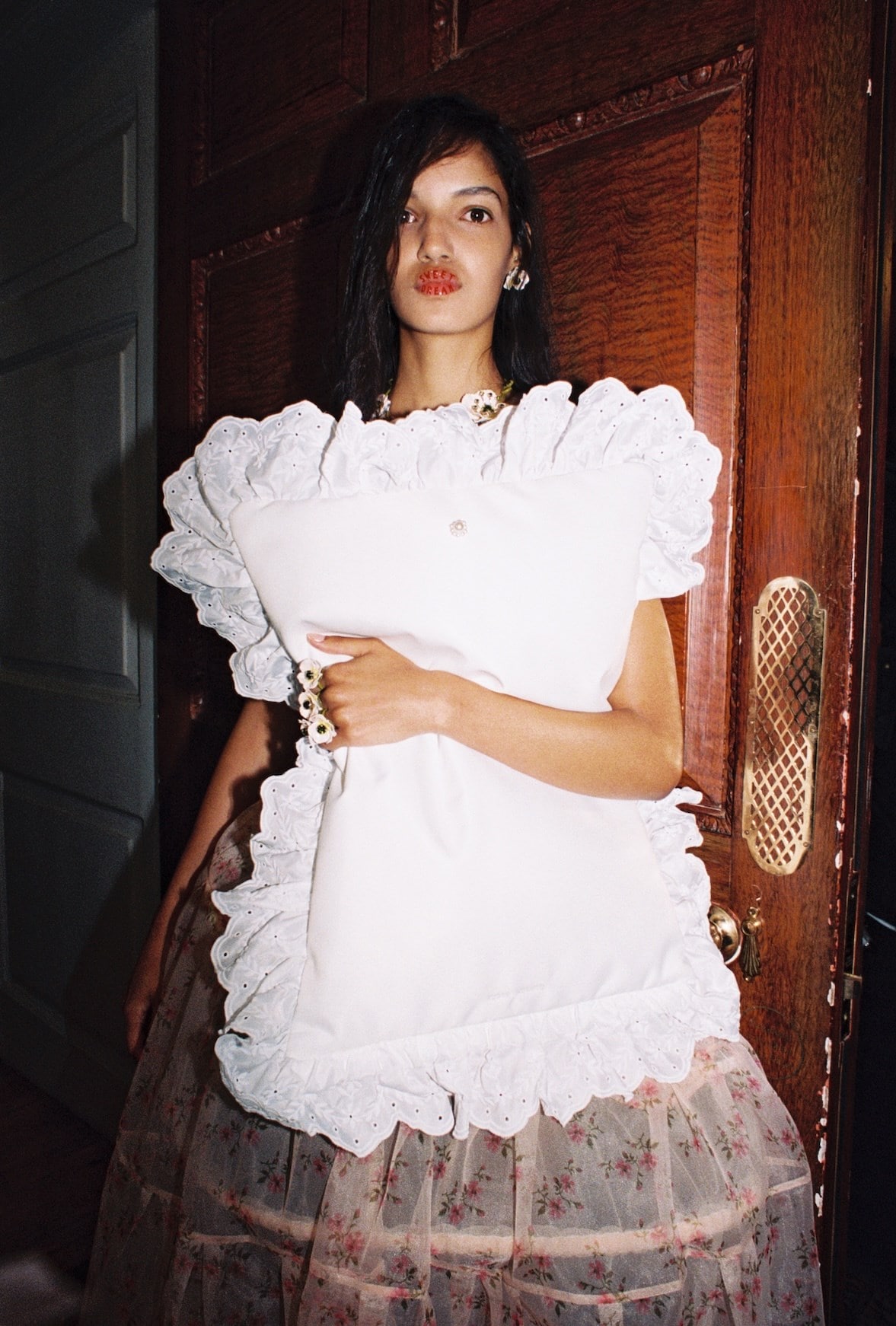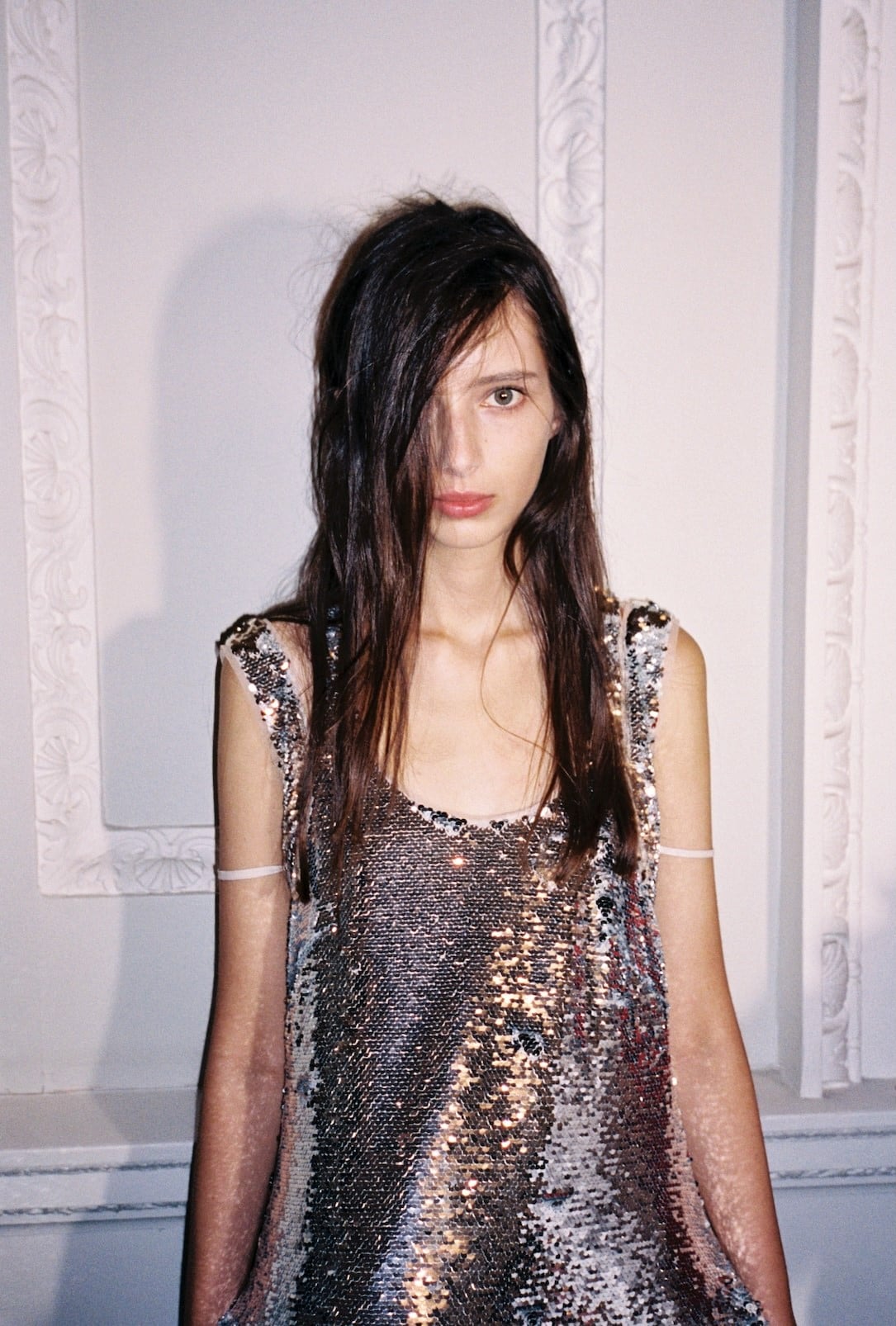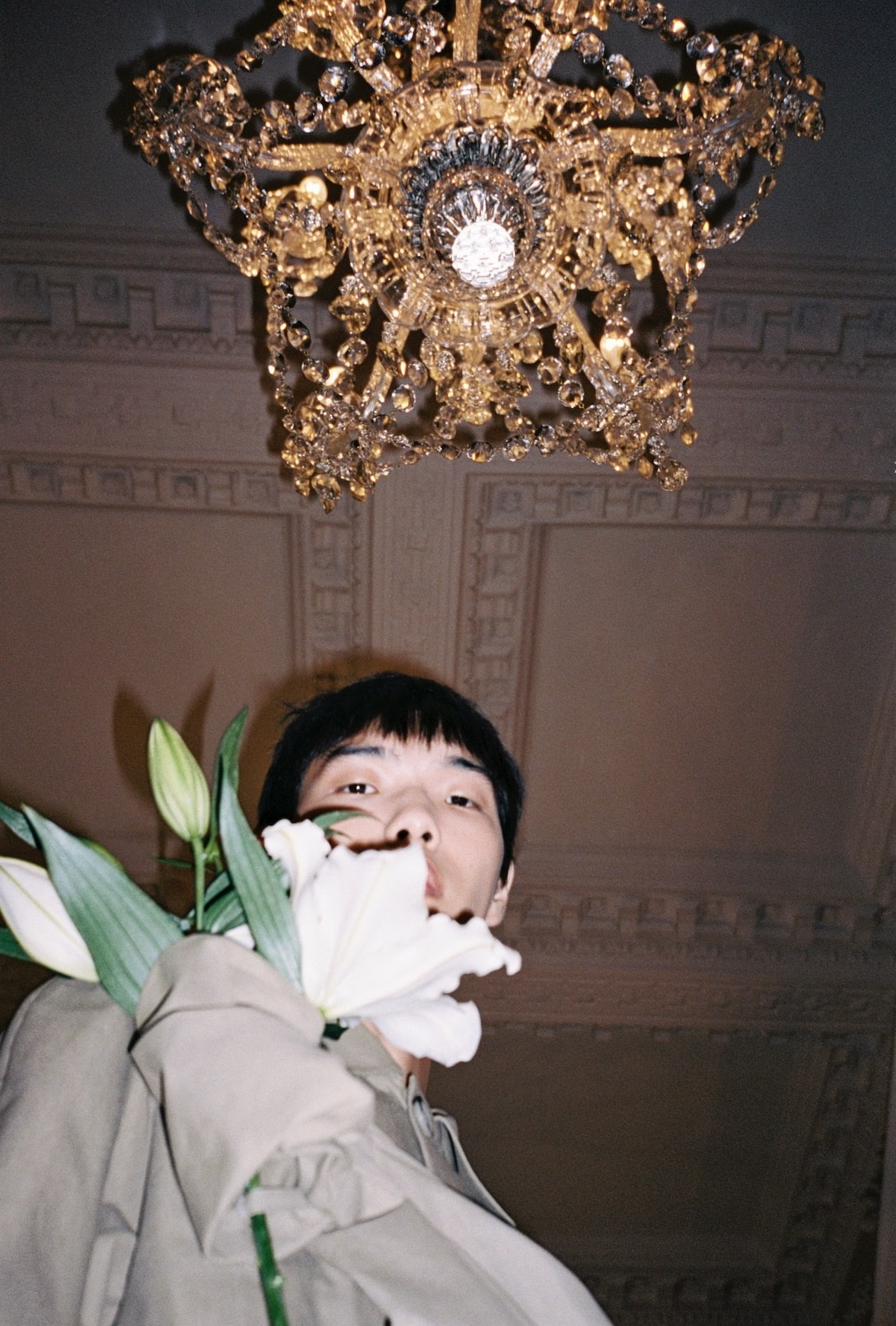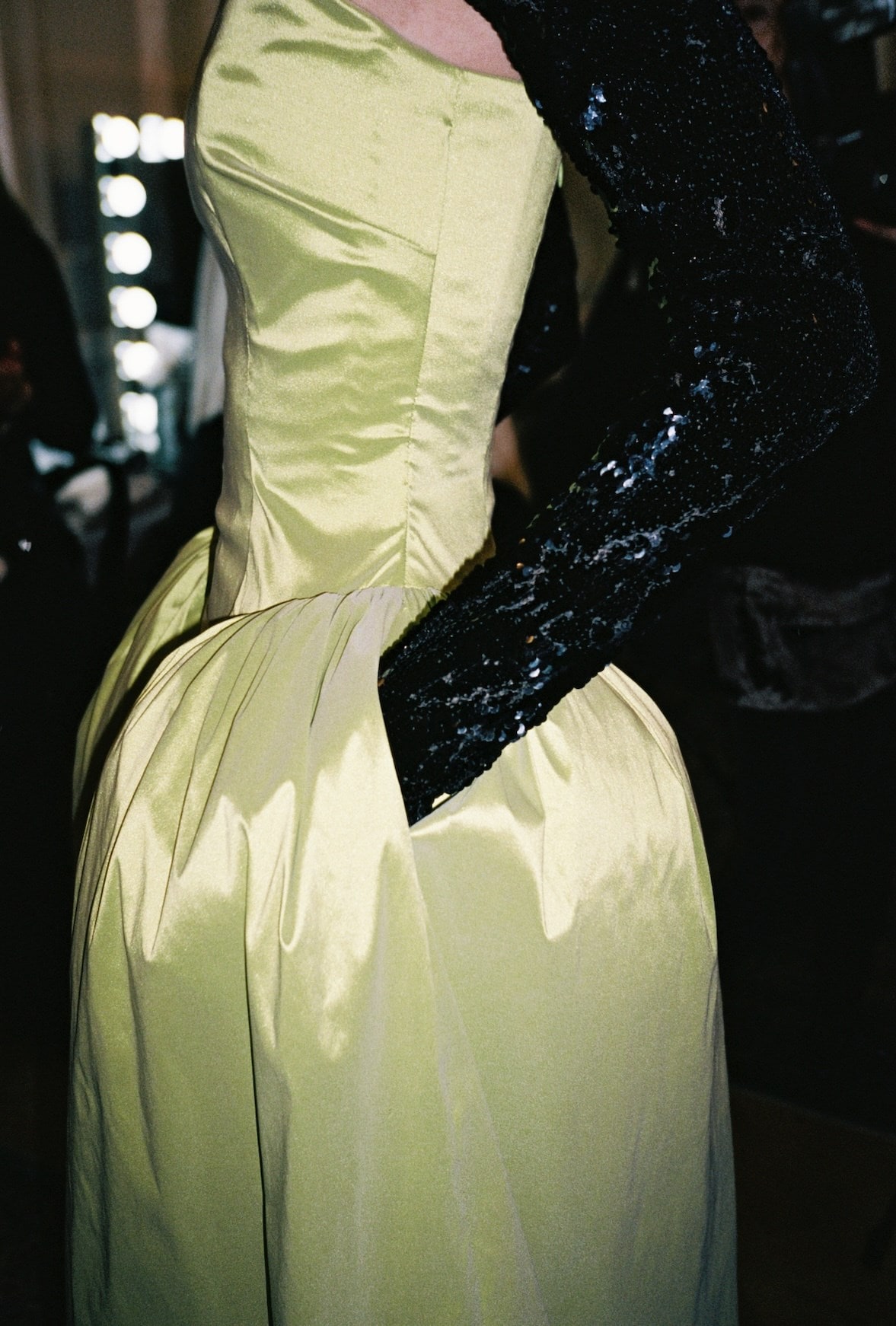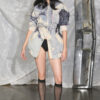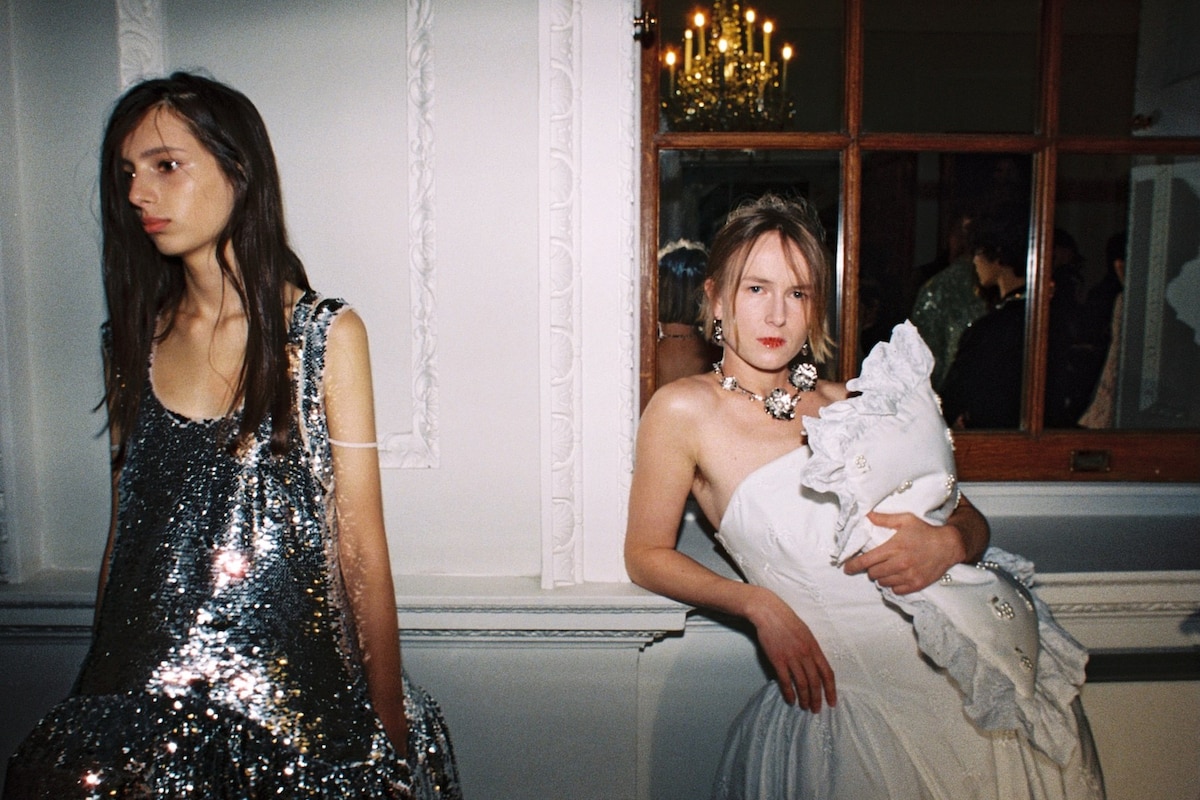
Rewrite
Lead ImageSimone Rocha Spring/Summer 2026Photography by Isabel MacCarthy
In her new studios in Dalston, east London, a model is walking past Simone Rocha and her show stylist, Robbie Spencer, in a somewhat cack-handed panier skirt. Hopefully, Rocha won’t mind me writing that – because it’s certainly true. The paniers in question, unlike Marie Antoinette’s, buckle and twist around the body, their lines sloping and asymmetric, their hemline left raw and trailing. Yet each undulation, although random, is intentional, each mistake carefully calibrated, if not precisely calculated. Rocha loves the look of the unfinished and undone, but it’s actually only achieved as the result of lots of hard work. “Maybe it doesn’t have to be perfect,” she says. It’s not really a question.
This collection was Rocha’s 30th, marking 15 years in business. “I didn’t realise,” she shrugs. Then again, her collection was inspired, in part, by the act of giving – as in a celebration. She was first inspired by the 1950s notion of couture, in particular, as a ‘proposition’ for clients – something she learned during her tenure as Jean Paul Gaultier’s resident couturier two years ago. What they meant by that is that couture houses would propose clothes to clients as a jumping off point, to slot into their lives, rather than as a head-to-toe designer proposition. Rocha does that, of course, but her fanbase really live in these clothes, mixing them into their real lives. Maybe those Rocha paniers have buckled because the wearers have slept in them – hence the models clutching pillows?
The notion of proposition led Rocha to proposal, to romance. “I wanted the whole collection to feel a bit like a gift,” she says. “Almost like being handed a bouquet.” Except Rocha’s bouquets are definitely, defiantly, east London bouquets. They may be Proustian Casablanca Lillies, but they’re wrapped in cheap plastic that coated a bunch of clothes from the collection, including a nasty little skirt that formed a funnel for a real life lily at one side. “Corner shop flowers,” Rocha says, laughing. “It’s bringing that romance down a peg.”
Other versions, however, came in rich brocades or trench coat gabardines pierced with blooms, while appliqués of taffeta flowers had both an endearing naivety and a throwback a hundred years or so to dresses of the 1920s known as robes de style, referential to 18th-century originals (paniers made a comeback back then too), yet lightened for the modern, free woman. Rocha is one of those, and her clothes always have a sense of lightness and a practicality, like a pin pricking potential prissiness.
“I kind of hate the word signature,” Rocha states. Yet, over the past two decades, signature styles of hers have slowly emerged. For this collection, she decided to play with them – sometimes consciously, often not. All that plastic, for instance, was present from her earliest shows, butting up here and there against broderie anglaise, or maybe layered over a bias-cut dress in slithery silk crepe de chine, like an heirloom reimagined. “I’ve worked in volume before, but I wanted to strip away, expose how we make them,” Rocha says – and that notion of the broken or imperfect is also a Rocha hallmark, in unravelling embroideries, frayed hems, twisted seams. Nods to mandarin collars, snapped in half, and the crossbody fastening of the qipao glanced to Rocha’s family roots in Hong Kong. And of course there were her ruffles, and her underwear references, and those bands of embroideries that, in Rocha’s hands, can look equally like jewellery or crystal scars, oddly placed, arresting.
If Rocha doesn’t like the term signatures, or codes, how about obsessions? These seem like obsessions, fixations, fetishes even, that she returns to time and time again, exploring differently, dissected and re-evaluated. And throughout, ceaselessly, there’s the power of the feminine, which is something of an overriding theme across Rocha’s work, more compelling than any fashion ‘code’. It’s all-pervasive, in the fabrication, her shapes, even across her menswear, which has a twisted take on a man’s wardrobe full of ruffles and flowers and embroideries across staples like trench coats and cotton collared rugby shirts that seem entirely modern, and potently at odds with the latent toxicity of much contemporary masculinity.
It’s not just because Rocha is a woman – there’s something deeper, about the values and meaning of femininity in a less than ideal world. Rocha’s clothes – her codes – are about nurture and care, tenderness and a search for beauty. Which includes, in its sweetest incarnation, an embrace of all its imperfections. That’s quite a legacy for a young London designer to have established. What a proposition.
in HTML format, including tags, to make it appealing and easy to read for Japanese-speaking readers aged 20 to 40 interested in fashion. Organize the content with appropriate headings and subheadings (h1, h2, h3, h4, h5, h6), translating all text, including headings, into Japanese. Retain any existing
tags from
Lead ImageSimone Rocha Spring/Summer 2026Photography by Isabel MacCarthy
In her new studios in Dalston, east London, a model is walking past Simone Rocha and her show stylist, Robbie Spencer, in a somewhat cack-handed panier skirt. Hopefully, Rocha won’t mind me writing that – because it’s certainly true. The paniers in question, unlike Marie Antoinette’s, buckle and twist around the body, their lines sloping and asymmetric, their hemline left raw and trailing. Yet each undulation, although random, is intentional, each mistake carefully calibrated, if not precisely calculated. Rocha loves the look of the unfinished and undone, but it’s actually only achieved as the result of lots of hard work. “Maybe it doesn’t have to be perfect,” she says. It’s not really a question.
This collection was Rocha’s 30th, marking 15 years in business. “I didn’t realise,” she shrugs. Then again, her collection was inspired, in part, by the act of giving – as in a celebration. She was first inspired by the 1950s notion of couture, in particular, as a ‘proposition’ for clients – something she learned during her tenure as Jean Paul Gaultier’s resident couturier two years ago. What they meant by that is that couture houses would propose clothes to clients as a jumping off point, to slot into their lives, rather than as a head-to-toe designer proposition. Rocha does that, of course, but her fanbase really live in these clothes, mixing them into their real lives. Maybe those Rocha paniers have buckled because the wearers have slept in them – hence the models clutching pillows?
The notion of proposition led Rocha to proposal, to romance. “I wanted the whole collection to feel a bit like a gift,” she says. “Almost like being handed a bouquet.” Except Rocha’s bouquets are definitely, defiantly, east London bouquets. They may be Proustian Casablanca Lillies, but they’re wrapped in cheap plastic that coated a bunch of clothes from the collection, including a nasty little skirt that formed a funnel for a real life lily at one side. “Corner shop flowers,” Rocha says, laughing. “It’s bringing that romance down a peg.”
Other versions, however, came in rich brocades or trench coat gabardines pierced with blooms, while appliqués of taffeta flowers had both an endearing naivety and a throwback a hundred years or so to dresses of the 1920s known as robes de style, referential to 18th-century originals (paniers made a comeback back then too), yet lightened for the modern, free woman. Rocha is one of those, and her clothes always have a sense of lightness and a practicality, like a pin pricking potential prissiness.
“I kind of hate the word signature,” Rocha states. Yet, over the past two decades, signature styles of hers have slowly emerged. For this collection, she decided to play with them – sometimes consciously, often not. All that plastic, for instance, was present from her earliest shows, butting up here and there against broderie anglaise, or maybe layered over a bias-cut dress in slithery silk crepe de chine, like an heirloom reimagined. “I’ve worked in volume before, but I wanted to strip away, expose how we make them,” Rocha says – and that notion of the broken or imperfect is also a Rocha hallmark, in unravelling embroideries, frayed hems, twisted seams. Nods to mandarin collars, snapped in half, and the crossbody fastening of the qipao glanced to Rocha’s family roots in Hong Kong. And of course there were her ruffles, and her underwear references, and those bands of embroideries that, in Rocha’s hands, can look equally like jewellery or crystal scars, oddly placed, arresting.
If Rocha doesn’t like the term signatures, or codes, how about obsessions? These seem like obsessions, fixations, fetishes even, that she returns to time and time again, exploring differently, dissected and re-evaluated. And throughout, ceaselessly, there’s the power of the feminine, which is something of an overriding theme across Rocha’s work, more compelling than any fashion ‘code’. It’s all-pervasive, in the fabrication, her shapes, even across her menswear, which has a twisted take on a man’s wardrobe full of ruffles and flowers and embroideries across staples like trench coats and cotton collared rugby shirts that seem entirely modern, and potently at odds with the latent toxicity of much contemporary masculinity.
It’s not just because Rocha is a woman – there’s something deeper, about the values and meaning of femininity in a less than ideal world. Rocha’s clothes – her codes – are about nurture and care, tenderness and a search for beauty. Which includes, in its sweetest incarnation, an embrace of all its imperfections. That’s quite a legacy for a young London designer to have established. What a proposition.
and integrate them seamlessly into the new content without adding new tags. Ensure the new content is fashion-related, written entirely in Japanese, and approximately 1500 words. Conclude with a “結論” section and a well-formatted “よくある質問” section. Avoid including an introduction or a note explaining the process.
